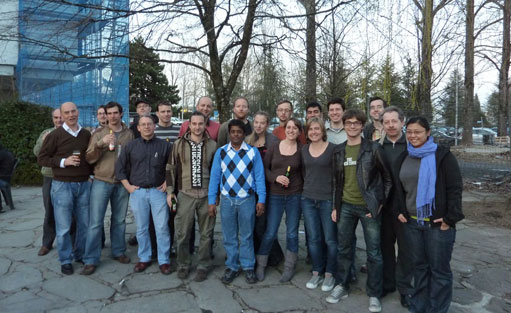
ATLAS e-News
23 February 2011
The making of the first paper
29 March 2010

Some of the many people who made the minimum bias paper happen
The first ATLAS physics paper – Charged-particle multiplicities in pp interactions at sqrt(s) = 900 GeV measured with the ATLAS detector at the LHC – was accepted for publication in Physics Letter B this week. It is the culmination of three months’ hard work and late nights on the part of those involved.
“We were under a lot of pressure to understand things quickly, and we attacked problems on a day-by-day basis,” recalls Maaike Limper, who counts herself among the lucky few analysts who managed to snatch a few days off at Christmas. “In January, my husband had to pick me up from CERN at midnight on several days. I also remember one [meeting] on a Sunday, which lasted ‘til midnight because we had to finish the first drafts of our notes by the Monday morning.”
The diligence paid off though; the analysis was ready and approved in time to be presented at the high-profile winter conferences. “It was amazing to see how problems that normally would have taken weeks or months of study were resolved in a few days by the consistent effort of all the group,” comments Maaike. Fellow analyst, Thorsten Kuhl agrees:
“It was really impressive how fast a small group could develop a full analysis chain, do data quality, get a scheme to process data and Monte Carlo very efficiently, and discover and solve problems.”
Indeed, scrutinising the data led to important improvements in the analysis – like revealing an underestimation of the passive material in the simulation of some parts of the detector – and caused a shake-up of the planned review structure, which ended up with tracking expert Andi Salzburger jumping in from the Review Committee to get involved in the analysis itself.
“In a very short timescale, from looking at the data, we realised that there was a small piece missing,” says Jamie Boyd, who was part of both the Review Committee following the analysis, and the Editorial Board in charge of finalising and homogenising the paper. “It would only be a small effect for most analyses, but it has a significant effect on this one, because of the low energy of the particles we’re looking at.”
Andi, together with Heather Gray and Grant Gorfine, were able to quickly fix the problem and re-make the simulation.
The spirit of pitching in didn’t end there; since the group were stretched for time and hands, the Editorial Board took responsibility for condensing the analysts’ internal (INT) notes and writing the final paper. “It was the first time our review and editorial processes had been tested, and so of course we were ironing out a few problems and procedural issues,” says Jamie.
As one of their first steps back in December, the three-person Review Committee initiated daily meetings to help keep track of the progress made by the fifteen or so core analysts working with the collision data. Ahead of the Christmas break, they defined ‘chunks’ of INT notes that needed to be tackled, grouped by topics like tracking, trigger, and background. The INT notes associated with the paper now number over 250 pages, the majority of which were written by dedicated analysts beavering away over Christmas and on into January.
ATLAS may have been quick, but CMS were a month quicker with their Minimum Bias paper. “We put our focus on rather detailed studies to understand detector performance with data,” explains Jamie. “This meant we were a bit slower than CMS.”
The analysis wasn’t just thorough – it was novel too. Rather than apply a theoretical model to interpret the data, as is the norm, ATLAS presented plain data, corrected for the known effects and inefficiencies of the Trigger and tracking systems. This makes it easier for theorists to use the data to constrain any new models they come up with, and the pioneering approach found particular favour with the journal referee.
“As an experimental physicist, the idea is not really to say ‘there’s this much of this type of process or this type of process’, because that depends on some theoretical model which you don’t know is true,” Jamie explains. “So we did a very model-independent analysis, which is the first time that’s been done for this kind of thing.”
The Minimum Bias paper was a good road-test for the ATLAS physics paper-producing machine. Not only that, other, previously unconsidered items – like Collaboration approval routes for additional material (auxiliary plots), which might be shown in presentations but not be in the final paper – evolved as a direct result of the exercise. Although the process of iterating with the entire Collaboration was a little “painful” at times, all this means that, hopefully, convergence will be swifter for future papers.
“They told me it would take 30 per cent of my time, and I’d say it took 100 per cent of my time,” Jamie laughs in assessment. “But this is probably natural with the first one… I think it’s fair to say that it was a learning experience.”
Like Jamie, Peter Mättig, the analysis reviewer, was also left with an overwhelmingly positive impression: “It was hard work, but it was enormous fun to finally work with data. I think with this paper ATLAS showed that we can publish high quality results and still be fast. Certainly we have learned a lot about our detector. And this allowed us to have results that really put theoretical models under test. When I started on the analysis I wouldn't have guessed we could achieve this already within a few weeks of data-taking.”
 Ceri PerkinsATLAS e-News
|